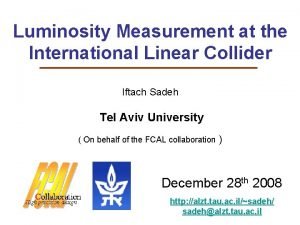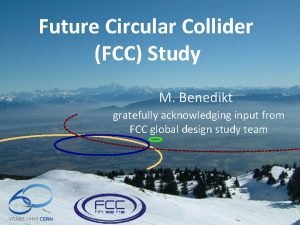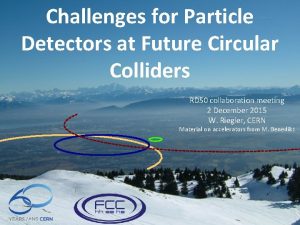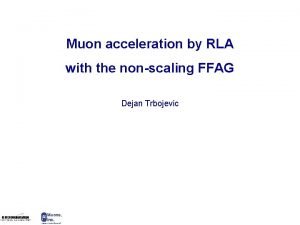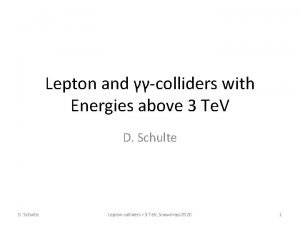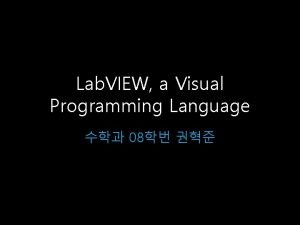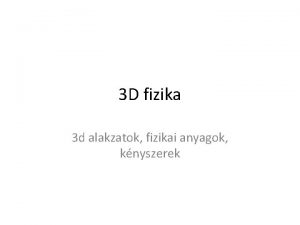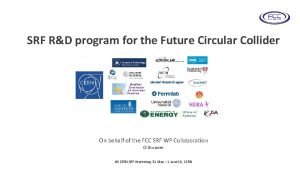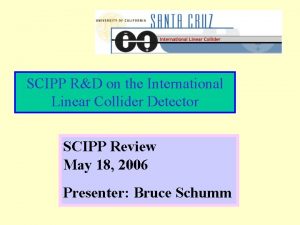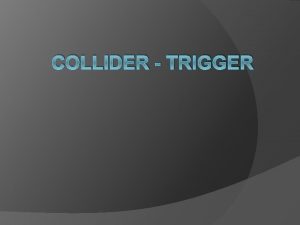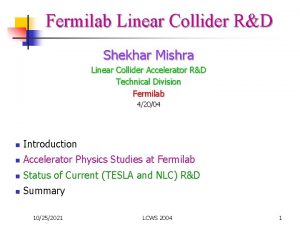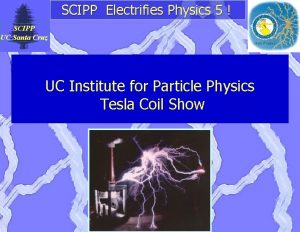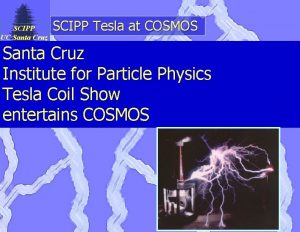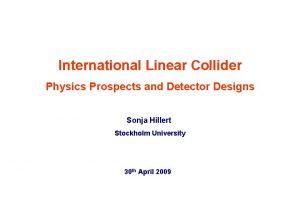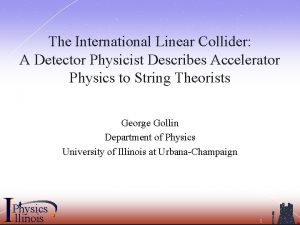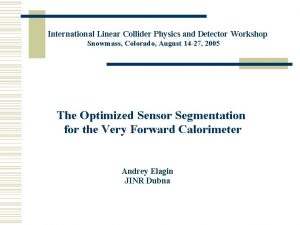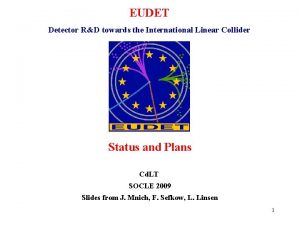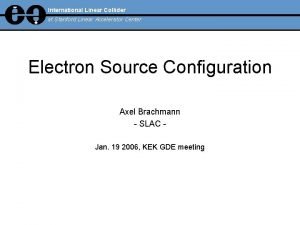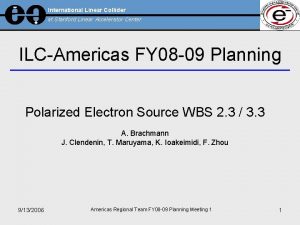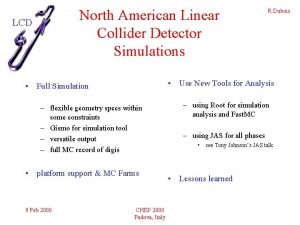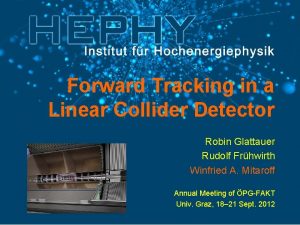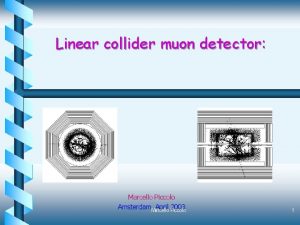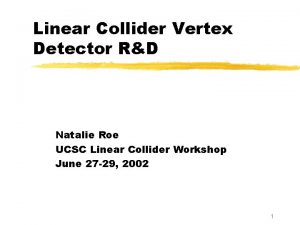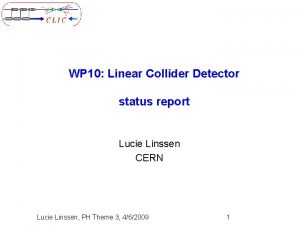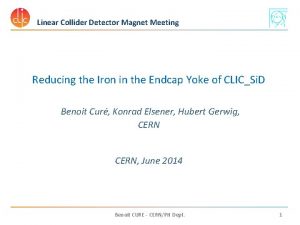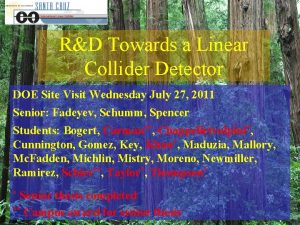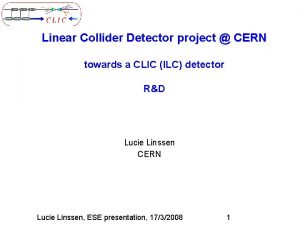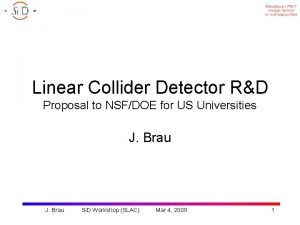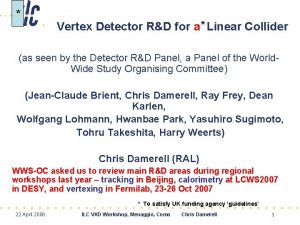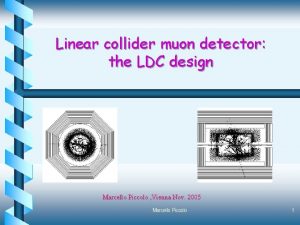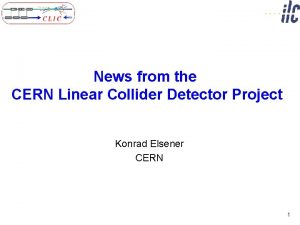SCIPP RD on the International Linear Collider Detector

































- Slides: 33

SCIPP R&D on the International Linear Collider Detector DOE Site Visit June 28, 2005 Presenter: Bruce Schumm

The Last SCIPP Slide on the SLD that You Will Ever See DIRECT MEASUREMENTS OF A(B) AND A(C) USING VERTEX/KAON CHARGE TAGS AT SLD Published in Phys. Rev. Lett. 94: 091801, 2005 Ac = 0. 6712 0. 0224 0. 0157 Ab = 0. 9170 0. 0147 0. 0145 • Best measurement of these parameters • Technique leads the way to future measurements (Giga. Z)

R&D Activity is increasing, with studies now on four fronts: Ø Physics and machine studies for e-e- running Ø Detector resolution standards from physics simulation Ø Reconstruction capabilities of all-silicon tracking Ø Hardware proof-of-principle of low-mass silicon tracking Current involvements (all very much part time) 3 senior physicists, 2 post-docs, 2 graduate students, 4 undergraduate thesis students, 1 Engineer, 1 technical staff, one bored spouse of a Silicon Valley engineer.

International Linear Collider: Activity on the e-e- Front Clem Heusch is the SCIPP participant in e-e- studies • Leading international effort in the use and application of e-e- beams at the ILC • Continuing series of workshops hosted by SCIPP; proceedings published in World Scientific • Heusch is a member of ILC Subcommittee on International Collaboration.

Detector Resolution Standards from Selectron Production Participants: Senior Physicist Bruce Schumm Undergraduate Thesis Students Troy Lau*, Joseph Rose, Matthew Vegas, Eric Wallace Community Member (on hold before Grad School) Ayelet Lorberbaum *Recipient of two Undergraduate Research Awards; grad school at U. Michigan this fall.

Original Motivation To explore the effects of limited detector resolution on our ability to measure SUSY parameters in the forward (|cos( )| >. 8) region. Si. D Tracker

SPS 1 Spectroscopy: At Ecm = 1 Tev, selectrons and neutralino are light. selectrons Beam/Brehm: √smin=1 √smax=1000 g =. 29 sz =. 11 (mm) LSP

Electron energy distribution with beam/bremm/ISR (. 16%). No detector effects or beam energy spread. Upper Endpoint Lower Endpoint • sample electron energy distribution Mselectron = 143. 112 (SPS 1 A)

Selectrons vs. cos( ) Roughly ½ of statistics above |cos( )| of 0. 8, but… SPS 1 A at 1 Te. V Electrons vs. cos( )

The spectrum is weighted towards higher energy at high |cos( )|, so there’s more information in the forward region than one might expect.

Determine the selectron mass accuracy in both the central (0 < |cos | < 1) and full (0 < |cos | < 1) region

Detailed Simulation of Si. D Tracking System (and Si. D variants) Participants: Senior Physicist Bruce Schumm Graduate Students Christian Flacco, Luke Winstrom, Michael Young* *Supported primarily through department (TA) funds; work deemed important enough that SLAC is paying for ½ of his support this summer.

Detailed Simulation of Si. D Tracking System (and Si. D variants), continued Two areas of work: Pulse Development Simulation Provides simulation of pulse development and amplification. Will soon be incorporated in international simulation framework (awaiting “hook” from Norman Graf at SLAC) Si. D Tracking Capabilities Explore tracking performance of five-layer Si. D tracker, as well as that of 8 -layer variant

Pulse Development Simulation Long Shaping-Time Limit: strip sees signal if and only if hole is collected onto strip (no electrostatic coupling to neighboring strips) Charge Deposition: Landau distribution (SSSim. Side; Gerry Lynch LBNL) in ~20 independent layers through thickness of device Geometry: Variable strip pitch, sensor thickness, orientation (2 dimensions) and track impact parameter Lorentz Angle: 18 mrad per Tesla (holes), from measurements

Carrier Diffusion Hole diffusion distribution given by Offest t 0 reflects instantaneous expansion of hole cloud due to space-charge repulsion. Diffusion constant given by h = hole mobility Reference: E. Belau et al. , NIM 214, p 253 (1983)

Electronics Simulation Detector Noise: From SPICE simulation, normalized to bench tests with GLAST electronics Analog Measurement: Employs time-overthreshold with variable clock speed; lookup table provides conversions back into analog pulse height (as for actual data) Will be incorporated into LCD simulation by Snowmass RMS Gaussian Fit Detector Resolution (units of 10 m)

Pattern Recognition Capabilities of an All. Silicon Central Tracker Si. D Tracker Can one do pattern recognition with only five central tracking layers? Might more layers improve performance to an extent that justifies the extra material?





Simulation Study Goals Focussed on Snowmass workshop: § Incorporate realistic pulse-development simulation (reconstruction efficiency in jet core) § Explore and optimize “outside-in” code making using of calorimeter clusters (Von Toerne, Onoprienko, Kansas State) § Characterize missed tracks § Study momentum resolution of fully simulated tracks § Explore extrapolation into ECAL (energy flow)

Hardware Development of Long Shaping-Time strip Readout for the Linear Collider Detector Senior Physicists Alex Grillo, Bruce Schumm Post-Doctoral Fellows Jurgen Kroseberg, Gavin Nesom Technical Staff Ned Spencer*, Max Wilder * Lead Engineer

The Longest Ladders of all: The Gossamer Tracker Q: Can the entire half-length be read out as a single element? Agilent 0. 5 m CMOS process (qualified by GLAST) Min-i for 300 m Si is about 24, 000 electrons Shaping ( s) 1 1 3 3 10 10 Length (cm) 100 200 Noise (e-) 2200 3950 1250 2200 1000 1850

Result: S/N for 167 cm Ladder At shaping time of 3 s; 0. 5 m process qualified by GLAST

Potential Advantages of the Gossamer Tracker Such a tracker may prove mechanically simpler, and offers the greatest possibility of competing with gaseous tracking at low p. We are awaiting the return of a prototype front-end chip, and designing the digital data-handling architecture.

Resolution With and Without Second (Readout) Threshold at shape=3 s Trigger Threshold 167 cm Ladder 132 cm Ladder RMS Gaussian Fit Readout Threshold (Fraction of min-i)

Design in 0. 25 m complete; to be received early July

The Long Shaping-Time Front-End (LSTFE) project represents SCIPP’s transition to deep sub-micron (0. 25 m) design. First attempt failed due to low-tech error (input pad connections), but we have now re-optimized for the cold RF technology (few-month turn-around). Full test and readout system developed in concert with PTSM (medical physics) system, awaiting arrival of prototype chip. Preparing to construct long microstrip ladder (1 -2 meters). Have also moved forward into FPGA programming, which has allowed us to do digital (back-end) designs with minimal engineering support…

Proposed LSTFE Back-End Architecture Low Comparator Leading-Edge-Enable Domain Li Hi Li+1 Hi+1 Li+2 Hi+2 Li+3 Hi+3 Li+4 Hi+4 Li+5 Hi+5 Event Time Li+6 Hi+6 Clock Period = 400 nsec FIFO (Leading and trailing transitions) 8: 1 Multiplexing ( clock = 50 ns)

Proposed LSTFE Back-End Architecture (cont’d) Per 128 Channel Chip: FIFO Controller FIFO Master FIFO 1 Master FIFO reads out 32 local FIFO’s Store in Master FIFO essentially complete by end of ~1 ms beam spill

Some Near-Term Goals for Hardware Development By Snowmass, hope to have proposed digital architecture programmed into an FPGA, and have tested it with simulated data stream (Nesom, Kroseberg). Also beginning to think of data transmission; several hundred fibers (1 per ladder) operating in burst mode. Expertise on campus in Electrical Engineering department on intermittent use of opto-electronic devices (Ken Pedrotti; is an inter-departmental member of SCIPP. Expect another submission to refine design and increase channel count for ~fall 2006 testbeam run.

ILC R&D SUMMARY For those with nearer-term physics project, ILC R&D provides a great avenue for advancing detection techniques and maintaining an institutional edge SCIPP is involved in many levels of studies aimed at defining and designing a tracker up to the task of exploring precision Linear Collider physics. While no one at SCIPP works on the Linear Collider as a primary commitment, we are doing critical-path work on detector R&D, and the work is an important part of our research program.
 International linear collider
International linear collider Fcc collider
Fcc collider Fcc collider
Fcc collider Bnl
Bnl Muon collider
Muon collider Visual basic programming language
Visual basic programming language Unity sphere collider
Unity sphere collider Hadron collider
Hadron collider Hadron collider
Hadron collider Cern future circular collider
Cern future circular collider Hát kết hợp bộ gõ cơ thể
Hát kết hợp bộ gõ cơ thể Slidetodoc
Slidetodoc Bổ thể
Bổ thể Tỉ lệ cơ thể trẻ em
Tỉ lệ cơ thể trẻ em Voi kéo gỗ như thế nào
Voi kéo gỗ như thế nào Tư thế worm breton là gì
Tư thế worm breton là gì Chúa yêu trần thế alleluia
Chúa yêu trần thế alleluia Các môn thể thao bắt đầu bằng tiếng chạy
Các môn thể thao bắt đầu bằng tiếng chạy Thế nào là hệ số cao nhất
Thế nào là hệ số cao nhất Các châu lục và đại dương trên thế giới
Các châu lục và đại dương trên thế giới Công của trọng lực
Công của trọng lực Trời xanh đây là của chúng ta thể thơ
Trời xanh đây là của chúng ta thể thơ Mật thư tọa độ 5x5
Mật thư tọa độ 5x5 Làm thế nào để 102-1=99
Làm thế nào để 102-1=99 độ dài liên kết
độ dài liên kết Các châu lục và đại dương trên thế giới
Các châu lục và đại dương trên thế giới Thể thơ truyền thống
Thể thơ truyền thống Quá trình desamine hóa có thể tạo ra
Quá trình desamine hóa có thể tạo ra Một số thể thơ truyền thống
Một số thể thơ truyền thống Cái miệng nó xinh thế chỉ nói điều hay thôi
Cái miệng nó xinh thế chỉ nói điều hay thôi Vẽ hình chiếu vuông góc của vật thể sau
Vẽ hình chiếu vuông góc của vật thể sau Biện pháp chống mỏi cơ
Biện pháp chống mỏi cơ đặc điểm cơ thể của người tối cổ
đặc điểm cơ thể của người tối cổ Ví dụ giọng cùng tên
Ví dụ giọng cùng tên
